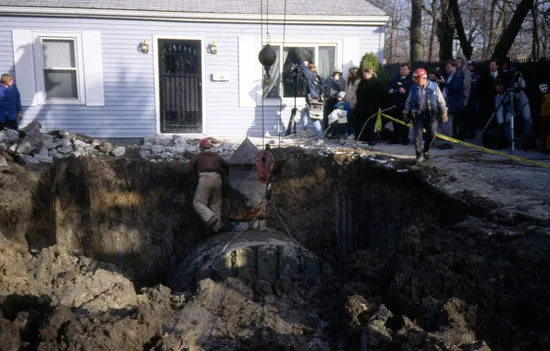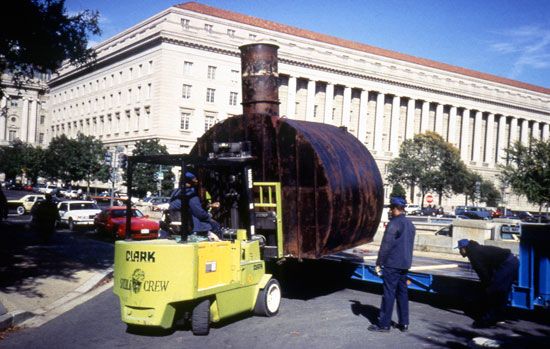How a Fallout Shelter Ended up at the American History Museum
Curator Larry Bird tells of the adventure—from Fort Wayne, Indiana, to Washington, D.C.
/https://tf-cmsv2-smithsonianmag-media.s3.amazonaws.com/filer/20120515105008family-fallout-shelter-web.jpg)
“We do not want a war. We do not know whether there will be war. But we know that forces hostile to us possess weapons that could destroy us if we were unready. These weapons create a new threat—radioactive fallout that can spread death anywhere.
That is why we must prepare.”
-The Family Fallout Shelter (1959), published by the United States Office of Civil and Defense mobilization
The Andersons of Fort Wayne, Indiana, were preparing for nuclear fallout even before the government disseminated this booklet, which includes building plans for five basic shelters. In 1955, the family of three purchased a steel fallout shelter, complete with four drop-down beds, a chemical pit toilet and a hand cranked air exchanger for refreshing their air supply, and had it installed 15 feet below their front lawn for a total of $1,800.
Neighbors watched as a crane lowered the shelter, resembling a septic tank, into a pit. A few years later, in 1961, there was reportedly more commotion, when, at about the time of the Berlin Crisis, the Andersons had the shelter reinterred. Because it had not been sufficiently anchored, with the area’s water table in mind, it had crept back up until it finally poked through the surface.
Larry Bird, a curator in the division of political history at the National Museum of American History, first heard about the Cold War relic in 1991. Tim Howey, then-owner of the Fort Wayne home, had written a letter to the museum. He had removed some trees and shrubs that had hid the shelter’s access point and a few ventilation pipes for years, and, as a result, was fielding more and more questions from curious passers-by. While Howey was tiring of the attention, there was clearly public interest in the artifact, and he wondered if perhaps the Smithsonian would want it for its collection.
At the time, Bird was on the lookout for objects that would tell interesting stories about science in American life. Some of his colleagues at the museum were preparing an exhibition on the topic and were trying to recruit him to curate a section specifically on domestic life. “I saw the letter, and I thought this is your science in the home right here,” recalls Bird.
The curator had to see the fallout shelter for himself, and in late March of 1991, he made a scouting trip to Fort Wayne. Louis Hutchins, a historian, and Martin Burke, a museum conservator, accompanied him. “When you actually see it and sit in it,” says Bird, “it raises more questions about just what they thought they were doing.”

For starters, in the case of nuclear attack, exactly how long was a family expected to stay burrowed in this tiny space? (Bird recently posted a video (embedded below) to YouTube of his first climb down into the shelter, which gives a sense of just how cramped the quarters are.) ”There is enough space for a six-foot person to stand up in the crown of it,” he says.
The curator found most government literature on fallout shelters to be pretty nondescript in terms of how much time had to pass after a bomb struck before it was safe to emerge, but the magazine Popular Science made an estimate. “The best guess now is: Prepare to live in your shelter for two weeks,” declared an article from December 1961. After being in it, Bird says, “That is probably about the length anyone would want to stay in one of these things before they killed each other or ran out of supplies and then killed each other.”
The fallout shelter, the museum team decided, was a powerful symbol of the fear that was so pervasive in the United States during the Cold War. “If you had money and you were frightened enough, it is the kind of thing that you would have invested in,” says Bird. And, in the 1950s and ’60s, many people, like the Andersons, were investing. “The shelter business is booming like a 25-megaton blast,” Popular Science reported.

The National Museum of American History arranged for Martin Enterprises, the company that had originally installed the shelter, to exhume it and haul it to Washington, D.C. on a flatbed. (As it turned out, the company did it for free.) “Some people thought that it would be so corroded. But you have to go along and do the job to find out,” says Bird. “It turned out it was fine.”
Until this past November, the family fallout shelter was on display in the museum’s long-running “Science in American Life” exhibition. A window was cut into the side of the double-hulled structure, so that visitors could peer inside. The museum staged it with sleeping bags, board games, toothpaste and other supplies from the era to suggest what it might have looked like when its owners had readied it for an emergency.
After his involvement in the acquisition, Bird started to get calls to let him know about and even invite him to other fallout shelters. “There are many, many more,” he says. “I imagine that the suburbs in Virginia and Maryland are just honeycombed with this kind of stuff.”
* For more about disaster shelters, read Smithsonian staff writer Abigail Tucker’s story on a recent boom in the luxury bomb shelter market.
/https://tf-cmsv2-smithsonianmag-media.s3.amazonaws.com/accounts/headshot/megan.png)
/https://tf-cmsv2-smithsonianmag-media.s3.amazonaws.com/accounts/headshot/megan.png)